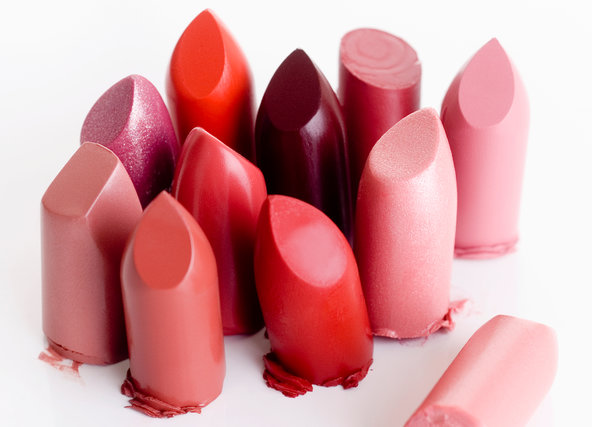|
Is There Danger Lurking in Your Lipstick?
Posted on: 08/21/13
 A soft pink, a glowing red, even a cyanotic purple — millions of women and girls apply lipstick every day. And not just once: some style-conscious users touch up their color more than 20 times a day, according to a recent study. But are they also exposing themselves to toxic metals? Most lipsticks contain at least a trace of lead, researchers have shown. But a new study finds a wide range of brands contain as many as eight other metals, from cadmium to aluminum. Now experts are raising questions about what happens if these metals are swallowed or otherwise absorbed on a daily basis. “It matters because this is a chronic long-term issue, not a short-term exposure,” said Katharine Hammond, a professor of environmental health sciences at the University of California at Berkeley and the lead author of the new analysis. “We’re not saying that anyone needs to panic. We’re saying let’s not be complacent, that these are metals known to affect health.” The issue first came to public attention in 2007 with a report on lead contamination in lipsticks, “A Poison Kiss,” by the Campaign for Safe Cosmetics. The Food and Drug Administration published an extensive follow-up in 2011, finding traces of lead in 400 lipsticks. Both the F.D.A. and the cosmetics industry insist that the average lead level found, just above 1 parts per million, or p.p.m., poses no real or unusual health risk. “Metals are ubiquitous,” said Linda Loretz, chief toxicologist for the Personal Care Products Council, an industry association. “And this is a very small amount, too small to be a safety issue.” But lead tends to accumulate in the body, noted Dr. Sean Palfrey, medical director of the lead poisoning prevention program at Boston University Medical Center. The F.D.A. itself sets a 0.1 p.p.m. safety standard for lead in candy intended for young children. “Not to mention that the C.D.C. acknowledged last year that no level of lead is really safe,” Dr. Palfrey said. And lead may not be the only concern. Dr. Hammond’s new study, published in May in the journal Environmental Health Perspectives, found traces of cadmium, cobalt, aluminum, titanium, manganese, chromium, copper and nickel in 24 lip glosses and eight lipstick brands. The researchers picked the products because they were favored by teenagers at a community health center in Oakland, Calif. The girls reported reapplying lipsticks or glosses as often as 24 times a day. Aluminum, chromium and manganese registered the highest concentrations over all, Dr. Hammond and her colleagues found. The average concentration of aluminum in the lip products, for instance, topped 5,000 p.p.m.; concentrations of lead averaged 0.359 p.p.m. Aluminum is added to lipsticks as a stabilizer, said Ms. Loretz: “It keeps colors from bleeding.” Titanium oxide is used as a whitening agent, softening reds into pinks. Both uses are approved by the F.D.A. But all of the other metals noted by Dr. Hammond are probably unwanted contaminants, Ms. Loretz said. For example, manufacturers often use glittery, microscopic flakes of mica, a naturally occurring mineral formation, to add shine to lip gloss. Mica routinely contains such metals as lead, manganese, chromium and aluminum. And there is some indication that more intense lipstick colors may carry a bigger metallic load because of contamination in pigments. In the F.D.A.’s 2011 analysis, the highest lead reading was found in a deep floral pink lipstick and the lowest in a neutral lip balm. A European study found that brown lipstick tended to be highest in lead, while researchers in Saudi Arabia reported that dark colors averaged 8.9 p.p.m. of lead, compared with 0.37 p.p.m. in light-colored lipsticks. Still, there remains a wide range of metal concentrations across colors and brands. To Dr. Palfrey, this suggests that cosmetic companies are able to control metal content when they choose. “It shouldn’t be a huge step for manufacturers to take out trace amounts of metals in a situation where they don’t know and we don’t know what’s safe for people who use them,” he said. Some metals are undoubtedly absorbed through mucosal tissues in the mouth, Dr. Palfrey added. And people do swallow lipstick, one reason that it’s so often reapplied. Given the continued debate about how much is absorbed, everyone — including the cosmetics industry — is pushing the F.D.A. to study the issue further. In the meantime, Dr. Hammond recommends that consumers take a common-sense approach to cosmetics. For starters, don’t let young children play with lipstick. “Treat it like something dangerous, because if they eat it we are taking about a comparatively large level of metals going into a small body,” she said. And be cautious about how often you reapply that shimmering color, Dr. Hammond added. Given the uncertainties, two or three times a day is all that beauty can reasonably demand. COMMENTS
Be the first to post a comment! Post A Comment:

|
.gif)



.jpg)

